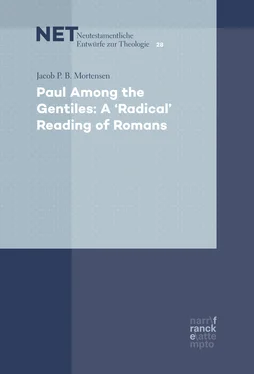In a 1995 article, Stanley Stowers argues that Rom 7:7–8:2 should be understood as speech-in-character or προσωποποιία.4 Also, in Stowers’ main opus, A Rereading of Romans , he argues that the imaginary conversation of 2:1–5, 3:1–9, and 3:31–4:2 ‘is best read with this ancient rhetorical technique of speech-in-character’.5 In general, I fully agree with this observation. However, whereas Stowers switches back and forth between a Gentile and a Jewish interlocutor for Paul, I stick to a Gentile interlocutor throughout, because it provides a more consistent and coherent reading of Romans. In the following pages, I will explain the theoretical background of speech-in-character, and why it makes more sense to stick with a single interlocutor throughout Romans. There are good theoretical reasons for sticking with the same interlocutor, and good exegetical reasons. Ultimately, the results of sticking to a single interlocutor are a more conceivable interlocutor who stands out as a definite persona , and a stronger interpretation of Romans in terms of continuity, unity, and coherence.
Aelius Theon opens his explanation of προσωποποιία in §8 of the Progymnasmata by stating that the author must, first, have in mind the personality of the speaker he wishes to present, and to whom the speech is addressed. This includes the speaker’s age and social status, the occasion, and the place. Then, the appropriate words must be chosen. Different ways of speaking belong to different stages of life, and different ways of speaking also belong by nature to women or men, by status, to slaves or freemen, by activities, to soldiers or farmers, by state of mind, to a lover and a temperate man, and by origin to a Laconian or an Attic man. The classic example given to students to consider is what words – and how to phrase them – Achilles might say as Patrocles lay dead and he was deliberating returning to battle. Theon specifies that to master these techniques one must not speak about great things vulgarly, nor about small things loftily, nor about paltry things solemnly, nor about fearful things in a casual manner, nor about shameful things rashly, nor about pitiable things excessively. The point is to give what is appropriate to each subject, aiming for what fits the speaker and his manner of speech, and the time and his lot in life (Theon 1997, 70-72).
Theon’s initial account of προσωποποιία tells us something very important about ancient readers and writers: They read/wrote with strict and stereotyped ideas of characterization. When they characterized a person, they deemed certain attributes to be consistently true of men, women, barbarians, Athenians, philosophers, and so forth.1 Consequently, if Jews at the time of Paul had a certain or stereotyped perception of Gentiles, then Paul would definitely bring such a perception to bear, when portraying a Gentile in writing. This would be self-evident to Paul, since his studies had taught him to visualize the personality he was to present in writing: through several exercises, he had learned to visualize the occasion and the social status of the speaker, and if he was to portray a typical Gentile in Rome, he would surely portray him with the occasion and the social status in mind. He had also learned to choose appropriate words and a specific way of speaking that would reflect the Gentile he wanted to portray, and he had learned to speak neither vulgarly nor loftily, but to present what would be appropriate to the subject in question, and aimed for what would befit the Gentile speaker. So, if he wanted to portray a Gentile, he would have to bring all these literary rules and guidelines together in a coherent and consistent presentation of the person, personality, or persona he wanted to portray.
The foregoing point is further substantiated by the fact that both Theon, and Quintilian (35–100 CE) in his Institutio Oratia – a more refined rhetorical work than the Progymnasmata , written for students at the third and rhetorical level of the literate education, but also dating to the 1 stcentury CE – explicitly include foreign ethnicity as a category for προσωποποιία. Theon writes that different ways of speaking belong to a Laconian or an Attic man, and he further emphasizes this ethnic category by discussing Herodotus’s ability to produce characterizations of barbarian speech. Quintilian praises the literary difficulty of impersonation ‘since it involves the portrayal of the emotions of children, women, nations ( populorum ), and even of voiceless things, all of which require to be represented in characterization’.2 A marvellous (and humorous) example of this ability to convey or imitate a person’s character, family, nationality, social status, and way of speaking is found in the Apocolocyntosis of Seneca the Younger (4 BCE–65 CE). Seneca makes the divus Augustus speak against the deification of the emperor Claudius (cf. Seneca Apocol , 10–11) in a heavenly court. Up to the point in the story where Augustus speaks, Seneca has several times pointed out the importance of nationality, language, parentage and homeland of the characters. And when Claudius arrives in heaven and is greeted by Hercules, Hercules addresses him in Greek (not Latin), and asks him about his race, his city and his parents (τίς πόθεν εἶς ἁνδρῶν, πόθι τοι πόλις ἠδὲ τοκῆες; Apocol 5). When the divus Augustus enters the stage, Seneca orchestrates a προσωποποιία in which he has Augustus speak in a way that mirrors and conveys the wording and phrasing of the Res Gestae Divi Augusti . Seneca presents Augustus by demonstrating and personifying his public persona in and through his speech (and text).3 The public image of the emperor who represents the moral high ground and appeals to the idealized Republican virtues is embodied in the speech Augustus delivers, making it an exquisite example of προσωποποιία. Hence, what all this comes down to is that if Paul uses προσωποποιία in Romans to stage a dialogue with a fictive Gentile interlocutor, his form, style, and application of literary rules and guidelines should enable us to identify a consistency of the speaker that corresponds to the person or type of character Paul presents. It all comes down to the point that the characterization must be consistent and thought-through, including with regard to ethnicity.
According to Theon, προσωποποιία is a literary or rhetorical device whereby an author places a speech in the mouth of a person to whom words are attributed that are suitable to the speaker and have an indisputable application to the subject discussed.4 In a very strict definition, προσωποποιία is limited to actual speech – that is, a person speaking while being ‘in character’. The Latin author Ovid exhibits complete mastery of this rhetorical technique in his Heroides . The Heroides is a series of speeches written as letters that famous persons might have delivered/written in a certain situation. Ovid presents us with speeches by Penelope, Briseis, Dido, Helen, Medea, Ariadne, and other famous mythico-historical personalities. Within the field of Classics it is commonly mentioned that Ovid uses προσωποποιία in the Heroides .5 However, I have not come across any New Testament scholar who compares the Heroides with Paul’s use of προσωποποιία in Romans. Instead, scholars seem to focus on diatribal features, and compare Paul to Seneca ( Epistles 88, 2:348–76) or Plutarch ( Moralia 469D, 6:194).6
If we more closely examine Theon’s Progymnasmata and Quintilian’s Institutio Oratia (and Cicero’s De Oratore ), we realize that the same rules apply to προσωποποιία and a diatribal dialogue. This is important, because there is considerable consensus among Pauline scholars that Paul employs diatribal features in Romans. In the 1995 article referred to above, Stowers even claimed that almost all the dialogical techniques characteristic of the diatribe would be types of προσωποποιία.7 The consequence of such an observation is that whether something should be characterized as a diatribal dialogue or as προσωποποιία is open to discussion. And this aspect has been absent in the works discussing Romans as a diatribe.
Читать дальше












